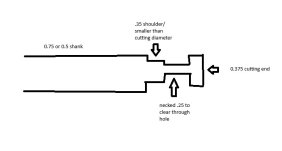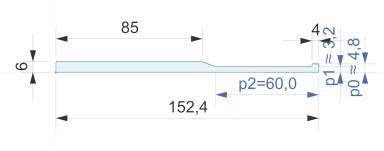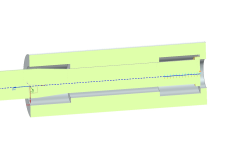Good morning Empower:
I've been noodling on your problem and here's what I would do if burning it is not an option.
I'd make my through hole 0.375" as close as I can ream it.
I'd buy an interchangeable shank for those interchangeable head endmills in 3/8" diameter.
I'd make up two rude and dirty boring heads to go on it, one for rough boring and one for finish boring.
I'd make the small one 0.490 and the bigger one right to size at the bottom of the tolerance.
I'd have a spiral grease groove ground into the shank so it can't pick up in the reamed bore.
I'd line bore the countersink after greasing the shank and poking it through the hole and threading my boring head onto it, using my 3/8 reamed bore as a line boring bushing.
Last I'd ream up the bore to 0.382" after removing the line boring bar.
If you line bore it like that you should be able to hold dimensions and concentricity...the biggest fuckarounds are making (or having made) the boring heads and fiddling them onto and off the shank for every damned hole.
I am pretending, of course, that they will repeat well for concentricity if you remove and replace them, but I'm told they're pretty good...within tenths
I don't know if Iscar or anyone else can supply blanks that you can get a tool grinding house to put a left hand spiral onto for doing the back bore, but you might be able to buy something stock and just have it butchered by a tool grinding house.
Failing that you can always make something up out of whatever steel you have laying around and put in a broken 1/8 endmill and then custom grind it to diameter basically like one of those old fashioned boring bars we've all used in decades past.
I'd personally try to have something ground up for me and I'd make the finishing tool with a LH spiral, RH cut reamer grind if the counterbore can tolerate a small chamfer at the bottom of it.
Obviously it's gotta be LH spiral, RH cut, so you can back bore with it without unscrewing the head from the shank while it's cutting.
It's still a bit of screwing around, but at least you can salvage the shank for other things and you don't have to deal with some skinny little nail hanging out a mile while you try to mill with it...it can be comparatively stout and you can just line bore with it instead of having to try to interpolate it.
Cheers
Marcus
www.implant-mechanix.com
www.vancouverwireedm.com






